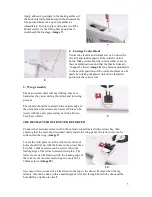
Apply adhesive sparingly to the mating surface of
the horizontal tail plane and push the fin assembly
into position. Remove any excess adhesive
immediately. Secure in place using the two M3 x
40mm screws via the fixing holes positioned
underneath the fuselage, (
image 7
).
7
4. Fuselage Control Rods
Centre the elevator and rudder servos. Connect the
elevator and rudder plastic links to their control
horns. Make certain that the control surfaces are in
their neutral positions and that the plastic links are
“snapped” closed, (
image 8
). Any minor adjustments
to the neutral positions of the control surfaces can be
made by rotating the plastic link on the threaded
portion of the control rod.
8
5. Wing Assembly
The main retract units will need fitting, these are
handed as they twist during the retract and lowering
process.
The wheels should be located on the outside edge of
the oleos when the retracts are lowered. This can be
tested with the units powered up, or with a Power-
Tech Servo Tester.
9
THE RETRACTS SHOULD 0EVER BE FORCED
Connect the electronic retract unit to the extension lead located in the retract bay, then
ensuring that the servo lead is tucked neatly inside the wing panel, the retract unit can be
sunken into the wing. (
image 9
)
Locate the twist plate on to the retract unit, the four
holes should line up with the holes in the retract base.
Two M3 x 20mm screws can be screwed into the
trailing edge of the retract unit and twist plate. The
retract cover can be lined up with the leading edge of
the retract cover and secured using two more M3 x
20mm screws. (
image 10
)
10
You may wish to connect the retract door to the leg so the door will close when the leg
retracts, this can be done with a small length of wire tied through hole in the door and the
hole halfway up the oleo itself.
5



























